|
|
|
Sort Order |
|
|
|
Items / Page
|
|
|
|
|
|
|
| Srl | Item |
| 1 |
ID:
157625
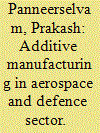

|
|
|
|
|
| Summary/Abstract |
Additive manufacturing (AM), also popularly known as 3-D printing, is revolutionising the global manufacturing landscape. The proliferation of AM technology has had a huge impact on the design and production capability of the manufacturing industry. At the same time, the technology to mimic and print real parts has huge implications for a country’s defence capability and security. In order to understand the growing importance of manufacturing technology in the digital age, the article focuses on the fundamental aspects of AM technology and how it is changing the aerospace and defence sector.
|
|
|
|
|
|
|
|
|
|
|
|
|
|
|
|
| 2 |
ID:
084743
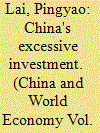

|
|
|
|
|
| Publication |
2008.
|
| Summary/Abstract |
China's economy has witnessed serious excessive investment over the past 5 years, mainly in the infrastructure and real estate. Excessive investment has adverse impacts on both economic growth and macroeconomic stability. The main causes of this excessive investment are inappropriate growth strategies, low interest rates and weak constraints on government investment expenditure. To effectively control excessive investment, China needs to adjust its growth strategy, to speed up the process of interest rate marketization, and reform the existing public expenditure system.
|
|
|
|
|
|
|
|
|
|
|
|
|
|
|
|
| 3 |
ID:
132746
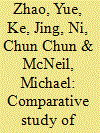

|
|
|
|
|
| Publication |
2014.
|
| Summary/Abstract |
The industrial sector consumes about 50% of the world×s delivered energy and thus has a large impact on the world×s energy production and consumption. Japan is one of the leading countries in industrial efficiency while China is the world×s largest industrial energy consumer. This study analyzes the energy consumption and efficiency of the Japanese and Chinese manufacturing industry. Analysis shows that the energy intensity of both Japanese and Chinese manufacturing industry has decreased significantly. Decomposition analysis shows that the efficiency effect played an important role in reducing energy intensity; improvement of the energy efficiency of both Japanese and Chinese manufacturing industry showed a trend of exponential decay. Structural effect significantly reduced the energy intensity of the Japanese manufacturing industry while having a relatively small influence on the energy intensity of the Chinese manufacturing industry. Our analysis also shows a strong association of industrial energy efficiency improvement with energy policies, highlighting that energy efficiency policies can play an important role in the reduction of industrial energy intensity. The results of this study also underscore the important, yet very challenging, task of achieving structural change to further improve efficiency.
|
|
|
|
|
|
|
|
|
|
|
|
|
|
|
|
| 4 |
ID:
190834
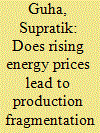

|
|
|
|
|
| Summary/Abstract |
How does the price of energy affect the extent of production fragmentation in India’s manufacturing industries? The prevailing literature has engaged with production fragmentation and trade in middle products for a long time, but the relationship between energy prices and production fragmentation is less understood. This article deals with firm-level panel data of India’s manufacturing industries between 2005 and 2018 to estimate the impact of rising energy prices on the outsourcing decisions/production organization of the manufacturing firms. The article also uses a number of covariates, including wages, welfare expenses, sales, profit after tax, dividend rate, foreign exchange earnings and an interaction term between energy prices and foreign exchange earnings. The empirical results of this article indicate that larger firms tend to outsource production in part to smaller firms in order to cope with rising energy prices and keep their profitability intact. Static and dynamic panel estimates with a variety of robustness analyses support the main conjectures.
|
|
|
|
|
|
|
|
|
|
|
|
|
|
|
|
| 5 |
ID:
034440
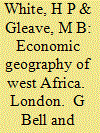

|
|
|
|
|
| Publication |
London, G Bell and Sons, Ltd., 1971.
|
| Description |
xii, 322p.Hbk
|
| Series |
Bell's Advanced Economic Geographies
|
| Standard Number |
0713517212
|
|
|
|
|
|
|
|
|
|
|
|
Copies: C:1/I:0,R:0,Q:0
Circulation
| Accession# | Call# | Current Location | Status | Policy | Location |
| 007736 | 910.133066/WHI 007736 | Main | On Shelf | General | |
|
|
|
|
| 6 |
ID:
106493


|
|
|
| 7 |
ID:
113678
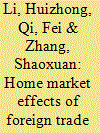

|
|
|
|
|
| Publication |
2012.
|
| Summary/Abstract |
In this paper, we use 2002-2008 International Standard Industry Classification two-digit bilateral trade panel data for manufacturing industries in China and the OECD countries to test for the existence of home market effects. We find that significant home market effects exist in 8 out of 12 industries. These industries include the food, beverage and tobacco industry, wood products, the paper products and printing industry, chemical products, other non-metallic mineral products, machinery and equipment, transport equipment, and miscellaneous products and waste resources recycling industry. Textile, clothing and leather manufacturing, oil refining and nuclear fuel manufacturing, rubber and plastics, and basic metals and fabricated metal products industries do not exhibit home market effects. Indeed, strong reverse home market effects occur for oil refining and nuclear fuel manufacturing and for the rubber and plastics industry. The empirical results reveal that certain industries benefit from new export opportunities due to the expansion of domestic demand in China.
|
|
|
|
|
|
|
|
|
|
|
|
|
|
|
|
| 8 |
ID:
115380


|
|
|
|
|
| Publication |
Surrey, IHS Global Limited, 2012.
|
| Description |
1189p.
|
| Standard Number |
9780710629951
|
|
|
|
|
|
|
|
|
|
|
|
Copies: C:1/I:0,R:0,Q:0
Circulation
| Accession# | Call# | Current Location | Status | Policy | Location |
| 056830 | 338.762910294/IHS 056830 | Main | On Shelf | General | |
|
|
|
|
| 9 |
ID:
149198


|
|
|
|
|
| Publication |
Surrey, IHS Global Limited, 2016.
|
| Description |
xcviii, 1242p.hbk
|
| Standard Number |
9780710632081
|
|
|
|
|
|
|
|
|
|
|
|
Copies: C:1/I:0,R:0,Q:0
Circulation
| Accession# | Call# | Current Location | Status | Policy | Location |
| 058885 | 338.762910294/IHS 058885 | Main | On Shelf | General | |
|
|
|
|
| 10 |
ID:
143408


|
|
|
|
|
| Summary/Abstract |
Our study documents the recent narrowing of the coast-inland divide in China. We argue that this rebalancing reflects, with a time lag, the catching up process which has been at work in the industry of the inland region since the end of the 1990s. The pattern is in line with the rapid and unconditional convergence observed in China's manufacturing industry over this period. The convergence of labor productivity suggests that advanced coastal regions have transferred capital and technology to the interior.
|
|
|
|
|
|
|
|
|
|
|
|
|
|
|
|
| 11 |
ID:
039765


|
|
|
|
|
| Publication |
Edinburgh, Oliver and Boyd, 1984.
|
| Description |
296pPbk
|
| Series |
Conceptual Frame Works in Geography
|
| Standard Number |
0050035258
|
|
|
|
|
|
|
|
|
|
|
|
Copies: C:1/I:0,R:0,Q:0
Circulation
| Accession# | Call# | Current Location | Status | Policy | Location |
| 024799 | 910.091716/BAR 024799 | Main | On Shelf | General | |
|
|
|
|
| 12 |
ID:
091184


|
|
|
|
|
| Publication |
2009.
|
| Summary/Abstract |
This will be Toyota's first operationg loss since 1938, which was just its second year of business. In 1950, amid the post-World War II turmoil, the company made a pretax loss and laid off some its employees, and Toyota Kiichiro resigned as president to take responsibility for the resulting labor dispute.
|
|
|
|
|
|
|
|
|
|
|
|
|
|
|
|
|
|
|
|
|